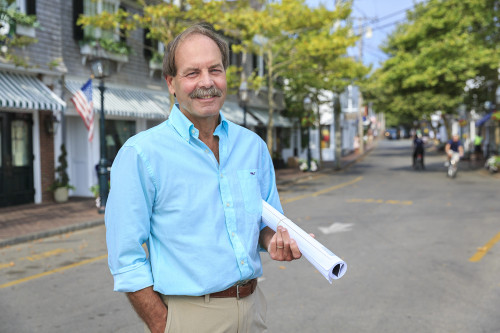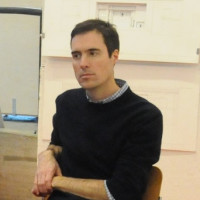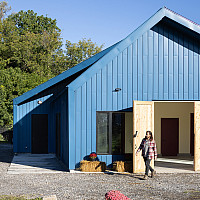The School of Architecture has announced that Patrick J. Ahearn FAIA ’73, G’73, one of America’s most celebrated classical architects, will address graduates at the 2025 Convocation ceremony on Saturday, May 10 at 10 a.m. in Hendricks Chapel.

Credit: Randi Baird PhotographyAhearn serves on the School of Architecture Advisory Board, is a Syracuse University trustee and is a member of the Syracuse University Boston Regional Council.
Ahearn is founding principal of Patrick Ahearn Architect, an award-winning Boston-based architecture firm specializing in classic American architecture for contemporary living. For over 50 years, he has designed historically motivated private residences, which have advanced the art of place-making in some of America’s most desirable and storied destinations.
From an early age, Ahearn knew he wanted to be a designer, but his first passion wasn’t architecture—it was cars. Through his fascination with automobiles, Ahearn’s initial appreciation for the power of good design and the importance of scale, proportion and light was born. And while this interest in car design sparked Ahearn’s earliest aesthetic awareness, growing up in Levittown, New York—the nation’s first planned suburb—helped him understand how good architecture and urban design could improve people’s lives and foster a true sense of community.
After earning a bachelor’s degree in architecture and a master’s degree in urban design from Syracuse University, Ahearn began his career in Boston, teaching at Boston Architectural College and designing for the Architects Collaborative and Benjamin Thompson & Associates. He worked on waterfront revival projects in Miami and Baltimore and new-build, mixed-use hotels and urban design initiatives in Cairo and Abu Dhabi, United Arab Emirates, along with renowned adaptive reuse projects including Boston’s Faneuil Hall Marketplace.
In 1978, Ahearn founded Patrick Ahearn Architect. Over the next 20 years, he revived hundreds of historic townhouses in the then-struggling Back Bay neighborhood of Boston and reinvigorated the commercial corridor of Newbury Street. Ever mindful of scale, proportion and context, Ahearn worked carefully within zoning, conservation and community regulations to balance preservation concerns with the need to design structures that felt timeless—an enduring signature of his work today.
In the early 1990s, Ahearn expanded his practice to the community of Edgartown Village on the island of Martha’s Vineyard, where much of his professional and personal energies were devoted for the better part of the three decades that followed. He has lent his expertise to more than 350 buildings—225 of them in the historic district alone—reimagining and redesigning many of Edgartown’s most notable private residences and public buildings. In the process transforming them into places and spaces for contemporary living, he has deftly blended them into the historic coastal landscape.
In the past 10 years, Ahearn’s commissions have taken him to locations farther afield, including California, Wisconsin, Ohio, Illinois, Maine, New Hampshire, Delaware, New York, New Jersey and Florida. Internationally he has designed residences on Vancouver Island and in both Australia and Scotland.
No matter the location, whether reviving centuries-old, landmarked structures along the coastlines or creating new homes that reimagine the local vernacular, Ahearn demonstrates an unparalleled ability to combine the romance of traditional architecture with the ideals of modernism. Through the practice of what he calls “narrative-driven architecture,” Ahearn creates a storyline for every home he restores, renovates or builds from the ground up.
Sensitive to the original spirit of every property and its surrounding neighborhood, Ahearn’s work ranges across a broad spectrum of project types, including master planning, new construction, historic renovation and restoration. His use of rich materials, artisanal craftsmanship and period details creates buildings that are so well suited to their context that they seem to have been built in the distant past.
Perhaps most importantly, Ahearn and his firm apply the “greater good theory”—a belief that architecture has the power to improve lives, increase happiness and encourage friendly and familiar interactions—to their work. This approach allows them to create what he calls “non-ego-driven architecture,” where the success of the project is judged on its capacity to enhance the public realm rather than on the architect’s singular design intentions.
Renowned for his skill and expertise, Ahearn has received many awards, including election to the American Institute of Architects (AIA) College of Fellows. His work has been featured in numerous publications and broadcast outlets, including Architectural Digest, The Wall Street Journal, House Beautiful, HGTV and many others.
Ahearn is a registered architect in 19 states, the District of Columbia, and British Columbia, Canada, and has earned the NCARB Certificate. He is also professionally associated with the Boston Society of Architects, the Boston Architectural Center, the Boston Preservation Alliance, the National Trust for Historical Preservation, the Back Bay Neighborhood Association, the Back Bay Architectural Commission, the Town of Wellesley Planning Board, the Town of Wellesley Design Review Board and is a former Chairman of the Board of the Martha’s Vineyard Preservation Trust.
He has taught at the Boston Architectural College, the Harvard University Graduate School of Design, the Rhode Island School of Design, and Syracuse University’s own School of Architecture.
Patrick Ahearn’s acclaimed monograph, “Timeless,” was published in 2018 and is in its seventh printing. His second published book, “History Reinterpreted,” was published in 2023 and details the architectural process that transformed an historic seaside hotel into a gracious bayfront estate.











